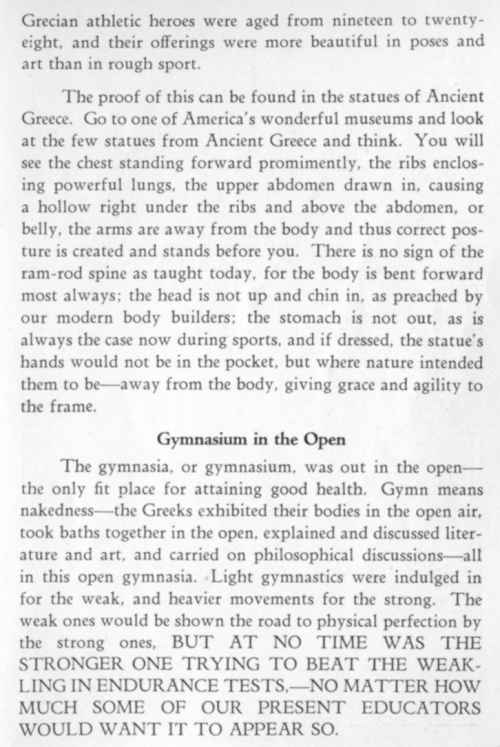cp 71

Grecian athletic hcroes were aged from ninctecn to twenty-eight. and thcir offcrings were morę bcautiful in poscs and art than in rough sport.
The proof of this can bc found in the statucs of Ancient Grecce. Go to one of America'* wonderful museums and look at the fcw statues from Ancient Greece and think. You will see the chest standing forward promimently. the ribs enclos-ing powerful lungs. the upper abdomen drawn in. causing a hollow right under the ribs and above the abdomen. or belly. the arms are away from the body and thus correct posturę is created and stands bcforc you. There is no sign of the ram-rod spine as taught today. for the body is bent forward most always; the head is not up and chin in. as preachcd by our modern body builders: the stornach is not out. as is always the case now during sports. and if dressed. the statuę s hands would not bc in the pocket. but where naturę intended them to be—away from the body. giving grace and agility to the frame.
Gymnasium in the Open
The gymnasia. or gymnasium. was out in the open— the only fit place for attaining good health. Gymn means nakedness—the Greeks exhibited their bodics in the open air. took bat lis together in the open. cxplained and discusscd literaturę and art. and carricd on philosophical discussions—all in this open gymnasia. Light gymnastics were indulged in for the weak, and heavier movements for the strong. The weak ones would bc shown the road to physical pcrfection by the strong ones. BUT AT NO TIME WAS THE STRONGER ONE TRYING TO BEAT THE WEAK-LING IN ENDURANCE TESTS.—NO MATTER HOW MUCH SOME OF OUR PRESENT EDUCATORS WOULD WANT IT TO APPEAR SO.
Wyszukiwarka
Podobne podstrony:
"firipped me from beginning to end—dark, creepy and suspenseful. I loved ii." - JAMES
From Cover to Cover Evaluating and Reviewing Children s Books Kathleen T Horning KATHLEEN T. HORNI
"firipped me from beginning to end—dark, creepy and suspenseful. I loved ii." - JAMES
that they receive from public performances at births and weddings by servicing men sexually in secre
Produkcja High precision balaru; from mg to kg iuńiidity and temp ąanitoring Peristaltic
ACID-ALCOHOL DEGRADA TION OF STARCH 101 sealed. The samples were heated from 25 to 120°C at a heatin
bi-monthly from June to October. Large numbers of Pratylenchus penetrans were found at 4 of the
The nineteenth century - important dates from the period - There were great change
bi-monthly from June to October. Large numbers of Pratylenchus penetrans were found at 4 of the
a great contribution to soil mechanics and were continuing to do so. It appeared, from what Pro
boorstin14 IOO From Trayeler to Tourist: these were seldom open to the public. In ancient days, and
ernstandyoung 01 Ernst &Young From Thought to Finish
00320 ?5cd1011755558fd005661a9b3cd8ed 323 Optimizing Defect Levels and Losses from Gage Errors Defe
więcej podobnych podstron